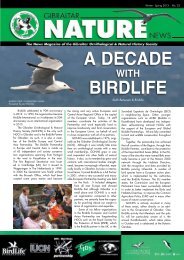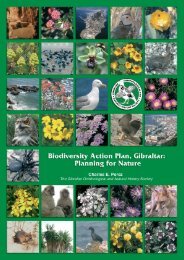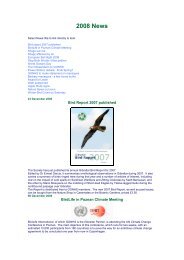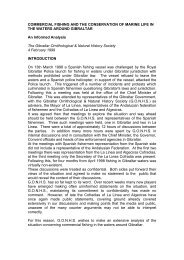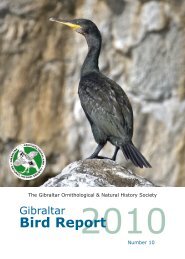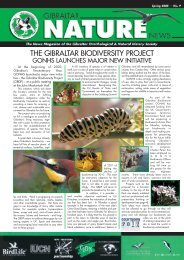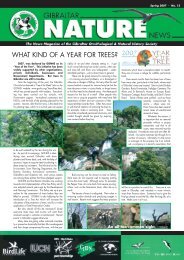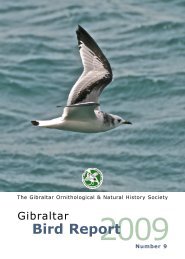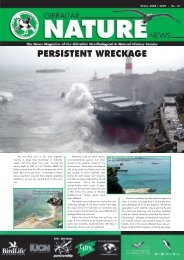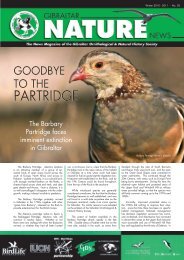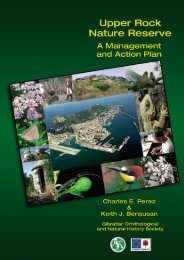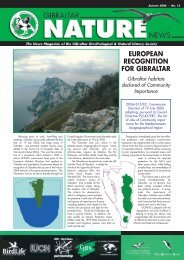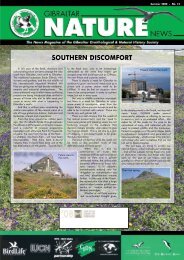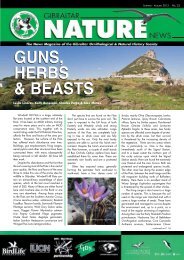ure News 11 - Gibraltar Ornithological & Natural History Society
ure News 11 - Gibraltar Ornithological & Natural History Society
ure News 11 - Gibraltar Ornithological & Natural History Society
You also want an ePaper? Increase the reach of your titles
YUMPU automatically turns print PDFs into web optimized ePapers that Google loves.
Quercus suber in the mist<br />
The mammal fauna of these woods is rich<br />
and abundant in areas. Predators are represented<br />
by the Red Fox Vulpes vulpes, Badger<br />
Meles meles, the common but highly nocturnal<br />
Small-spotted Genet Genetta genetta and the<br />
more diurnal Egyptian Mongoose Herpestes ichneumon.<br />
These last two species share a predominantly<br />
African distribution; both are widespread<br />
in the Afrotropics. Although the Genet<br />
extends into France, it is likely that both species<br />
were originally introduced to Iberia by the<br />
Moors, perhaps in an effort to control vermin.<br />
Present for hundreds of years though, they are<br />
well established elements of the mammalian<br />
fauna of Iberia. Large ungulates are also present.<br />
Male Roe Deer Capreolus capreolus can be<br />
heard barking in the woods during the autumn<br />
months. Although the habitat is prime for Wild<br />
Boar Sus scrofa, the population of this species in<br />
‘Los Alcornocales’ has been diluted by feral pigs<br />
which have interbred with their wild counterparts.<br />
Near the top of the Sierra del Bujeo, at<br />
around 750m above sea level, lies the Llano del<br />
Juncal. This is a truly magical area. The Llano<br />
itself is a flat and at-times boggy area of grasses<br />
and rushes. This creates an opening within<br />
extensive woodland of the deciduous Portuguese<br />
Oak Quercus faginea. The approach to the<br />
Llano del Juncal is of exceptional beauty.<br />
Frequently shrouded in cloud (often the infamous<br />
Levanter), these woods are often referred<br />
to as ‘cloud forest’. The exceptionally humid<br />
conditions allow the formation of thick clumps of<br />
moss, which hang off trees and rotting branches.<br />
Searching within these mosses, or under rotting<br />
branches or logs, may reveal the beautiful<br />
black and yellow Fire Salamander Salamandra<br />
salamandra. Another feat<strong>ure</strong> of these woods<br />
which reflects their humidity is the understorey,<br />
which is composed in part of native<br />
Rhododendrons Rhododendron ponticum<br />
baeticum. This plant is a relic of cooler periods<br />
and is now largely restricted to watercourses in<br />
southernmost Spain and Portugal. However, the<br />
woodland around the Llano del Juncal is humid<br />
enough for the species to grow freely in the<br />
understorey. Beautiful Calopteryx damselflies<br />
are common in the area, as well as the stunning<br />
yellow and black dragonfly Cordulegaster<br />
Frangula alnus<br />
boltonii, especially<br />
along streams.<br />
Leaving the woodland,<br />
a scrub composed of<br />
Erica species and<br />
Cistus populifolius may<br />
reveal Sardinian<br />
Warblers Sylvia<br />
melanocephala and<br />
Dartford Warblers<br />
Sylvia undata. On the<br />
slopes, Holly Ilex<br />
aquifolium towers over<br />
the Cork Oaks. This<br />
plant, which is common<br />
in central and<br />
northern Europe, is<br />
very rare and localised<br />
so far south. Finally,<br />
one is met with a stunning<br />
view across the<br />
bay, including the Rock<br />
of <strong>Gibraltar</strong> with the<br />
horizon above it!<br />
Most of the woodland<br />
on the southern<br />
shore of the Strait suffers<br />
from degradation,<br />
particularly overgrazing<br />
of goats and<br />
sheep. With the<br />
exception of Bouhachem between Tetouan and<br />
Chefchaouen, cork oak woodlands in Morocco<br />
are now by and large in a very poor state compared<br />
to their Spanish counterparts. This makes<br />
it especially important to conserve those areas of<br />
woodland that are in good condition. The designation<br />
of the ‘Alcornocales’ reserve goes some<br />
way towards achieving this. Having said that,<br />
some parts of these Cork Oak woods suffer<br />
from overgrazing by goats and sheep. Others<br />
are affected by the practice of ‘desbroze’, the<br />
clearing of understorey which, it is claimed,<br />
invigorates the growth of cork. Such claims<br />
remain unsubstantiated and are in any case<br />
firmly at odds with the conservation of plant and<br />
animal diversity within this important nat<strong>ure</strong><br />
reserve. A key word in environmental circles<br />
nowadays is ‘sustainability’. Although the commercial<br />
use of natural habitats often contributes<br />
towards their conservation, the resulting activities<br />
can sometimes be detrimental to their wellbeing.<br />
Large areas of the ‘Alcornocales’, including<br />
parts of the Sierra del Bujeo, are well-managed<br />
from a wildlife perspective. It is up to the<br />
management of the Reserve to ens<strong>ure</strong> that all<br />
areas are equally well managed. Most importantly,<br />
a balanced approach to the sustainable<br />
use of these important habitats should always be<br />
sought.<br />
NOTES & NEWS<br />
GIBRALTAR BEETLE IN RARE<br />
INVERTEBRATE PUBLICATION<br />
Buprestis sanguinea subsp calpetana, a beetle<br />
known only from <strong>Gibraltar</strong>, feat<strong>ure</strong>d in the<br />
recently published ‘Libro Rojo de los<br />
Invertebrados de Andalucía’. This publication,<br />
which deals with rare and threatened invertebrates<br />
in Andalusia, bases the inclusion of this<br />
jewel beetle on the possibility that populations<br />
may exist elsewhere in southernmost Iberia. The<br />
chapter on this species was prepared by Antonio<br />
Verdugo Paez, a friend of Charlie Perez and<br />
Keith Bensusan of the GONHS Invertebrate<br />
Section, with whom he described this beetle as<br />
new to science.<br />
SHORT-TOED EAGLE<br />
POISONED<br />
A Short-toed Eagle Circaetus gallicus that had<br />
been spending the winter on the Rock was<br />
handed in to the GONHS Raptor Rescue team<br />
recently, apparently with a broken leg. However,<br />
when inspected by local veterinarian Mark<br />
Pizarro, it transpired that the bird had in fact<br />
been poisoned, and that the weakness noted in<br />
the legs of the bird was a result of the toxin and<br />
not a breakage. It is likely that the poison had<br />
not been laid out for birds of prey, but rather<br />
against vermin, which the eagle may then have<br />
fed on. However, this highlights the danger that<br />
such baiting poses to wildlife. GONHS would<br />
like to take this opportunity to thank members of<br />
the public who hand-in birds that are inj<strong>ure</strong>d or<br />
ill, as well as the <strong>Gibraltar</strong> Veterinary Clinic for<br />
its untiring support of our raptor rehabilitation<br />
work.<br />
NATURAL HISTORY COURSE –<br />
AUTUMN 2008<br />
14 people attended the second course on<br />
<strong>Natural</strong> <strong>History</strong> organised by GONHS, and coordinated<br />
by Albert Yome and Leslie Linares.<br />
Everyone who attended enjoyed the experience,<br />
and learnt much about <strong>Gibraltar</strong>’s biodiversity<br />
and of the work and research being carried out<br />
by GONHS. Because of the time of year, the<br />
weather played its part in causing some outings<br />
having to be rescheduled, and also on numbers<br />
attending some lect<strong>ure</strong>s. Careful thought will<br />
have to be given as to whether autumn, and its<br />
unpredictable weather, is a good time to run a<br />
course or not.<br />
TRIPARTITE FORUM<br />
GONHS, the Environmental Safety Group, and<br />
the Spanish environmental group AGADEN,<br />
submitted a document, through the <strong>Gibraltar</strong><br />
Government, to the parties that make up the<br />
“Tripartite Forum” of discussion, the<br />
Governments of the United Kingdom, Spain and<br />
<strong>Gibraltar</strong>. This document was directed to the<br />
technical meeting held in autumn 2008, and<br />
was accompanied by an offer to provide more<br />
extensive information to the full political meeting<br />
in the spring. The groups urged the<br />
Governments to give priorities to environmental<br />
matters in their discussions, including the issues<br />
of pollution, the need for epidemiological studies,<br />
nat<strong>ure</strong> conservation outside protected areas,<br />
and the need to include <strong>Gibraltar</strong> and its waters<br />
in the Intercontinental Biosphere Reserve that<br />
currently includes only Spain and Morocco.<br />
GIBRALTAR NATURE NEWS<br />
9



